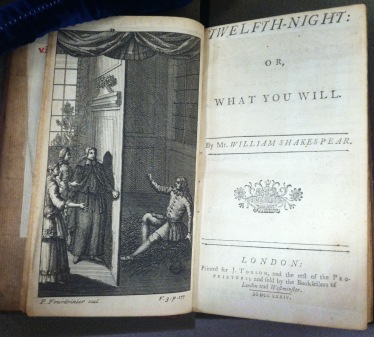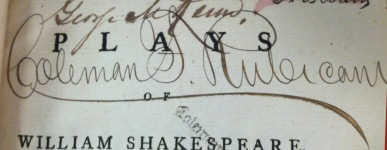The celebration of Twelfth Night traditionally takes place on either January 5th (yesterday) or January 6th (today) depending on whether you choose to count from Christmas Day or the day after. The holiday celebrates the Epiphany, or the coming of the Magi to visit the Christ Child 12 days after His birth, and has been celebrated for centuries in Christian countries with feasting, drinking, and general merriment. Twelfth Night is also the title of one of Shakespeare’s most popular comedies, a play about love and folly. While the main plot of the play is about the main characters finding the person they love (with lots of cross-dressing, mistaken identity and confusion along the way), the major sub-plot of Shakespeare’s Twelfth Night is about the tensions between the puritanical character, Malvolio, who frowns on feasting and frivolity, and the fool, Feste, who is all for mirth in the moment, declaring that “present mirth hath present laughter.”
Today in Philadelphia, and perhaps where you are too, the world is covered in white, the falling snow a pleasure to watch from inside a warm room, but chilling and damp to walk through. It is easy to understand, on a day like today, why people since Shakespeare’s day have looked forward to the Twelfth Night holiday as a time to concentrate on the pleasures of food, drink and companionship while the winter winds blow outside, and Shakespeare’s comedy seems like the perfect book to escape into, curled up in a cosy corner of a library. Indeed, it is a play so filled with “present mirth”, that I do not believe I have never seen a production of the play or an image depicting a scene from it that, despite the fact that the title implies a January setting, do not depict the scenes as taking place in spring or summer. This is true, for example in the engraving facing the title page of a 1735 edition of Twelfth Night shown at the top of this post (Penn Libraries 90 1735), which depicts a scene in the play contrasting the would be party pooper Malvolio, who has been shut up in a light-less room, while the other characters stand in sunshine with the leaves of trees showing through the window behind them. It is also true of the springtime woodcut with frolicking cherubs and fountain chosen to top the title page for the play from a 1726 edition:
For today’s POP post, I’ve selected images of some provenance signatures from Penn Library collections that appear on title pages of two eighteenth century editions of Shakespeare’s Twelfth Night. Both images are taken from the title page of the volume containing Twelfth Night from a multi-volume set of Shakespeare’s complete works. The first is the main title page from the same 1726 edition that the woodcut above appears in (Penn Libraries 90 1726P, vol. 3):
The name inscribed in the upper right-hand corner may read “Thomas Coopers” (It isn’t clear whether the mark with the “S” following “Cooper” is meant to be a possessive with a flourish, or an abbreviation for an additional word like Senior, or Smith):
The other title page comes from a 1773 edition of Shakespeare’s works (Penn Libraries 90 1773J c.2 vol. 3):
This title page contains three provenance inscriptions and a stamp. In the upper right hand corner appears the name “J. S. Story/St. Albans”:
Next, the name “George M Keim.”:
And finally the name Coleman F. Rubicam, which is both written (very grandly), and stamped in the book:
None of the names appearing in these books have currently been identified, so they remain, for now, anonymous fellow readers who may have, a few centuries ago, picked up these copies of Twelfth Night on a snowy day when the world was cold outside and warm within, to escape into the timeless, sunny world of Shakespeare’s comedy.
If you know something to share about the identity of one of these Shakespeare readers, post a comment to the POP Flickr feed by clicking on the “View Image on POP” links below each image, or comment on this blog post. Visit the main POP Flickr feed by clicking here.













A man called J. S. Story of St Albans was Clerk of the Peace for the County of Hertford in 1833-4: https://books.google.co.uk/books?id=irhDAQAAMAAJ&dq=j%20s%20%22story%22%20%22st%20albans%22&pg=PA220#v=onepage&q=j%20s%20%22story%22%20%22st%20albans%22&f=false
https://books.google.co.uk/books?id=uv8uAAAAIAAJ&dq=j%20s%20%22story%22%20%22st%20albans%22&pg=PA30#v=onepage&q=j%20s%20%22story%22%20%22st%20albans%22&f=false
https://www.google.co.uk/search?tbm=bks&hl=en&q=j+s+%22story%22+%22st+albans%22+clerk+of+the+peace#safe=off&hl=en&tbm=bks&q=j+s+%22story%22+%22clerk+of+the+peace%22
LikeLike
A John Samuel Story died in St Albans in 1851: http://www.freebmd.org.uk/cgi/information.pl?scan=1&r=17293082:7854&d=bmd_1419318740
LikeLike
George M. Keim is presumably this man, a Philadelphian:
https://en.wikipedia.org/wiki/George_May_Keim
although the signature is not _identical_ to the one here: http://www.ebay.co.uk/itm/US-Rep-Penn-GEORGE-M-KEIM-AUTOGRAPH-COA-/380048813381
LikeLike
Since it’s a multi-volume Shakespeare set, I think there may be other examples of Keim’s signature in our books. I’ll see if any look a little closer to the image of the congressman’s autograph you posted.
LikeLike
Rubicam’s middle initial is “F” not “S”, so he is perhaps this man, another Philadelphian:
http://www.findagrave.com/cgi-bin/fg.cgi?page=gr&GRid=104274975
LikeLike
A palpable F! So much for hasty transcription at the end of a long work day. I think the Civil War soldier you link to indeed seems the most likely candidate. Thanks for the useful comments.
LikeLike
John Samuel Story (d. 1851) was a banker and solicitor in St Albans. Mentioned in 1820 as agent to the first earl Verulam http://www.historyofparliamentonline.org/volume/1820-1832/constituencies/st-albans
His personal and financial history is told in detail in the pitiful record of his 1848 bankruptcy, documented in the Annual Commercial Register of 1849 https://books.google.com/books?id=LYgEAAAAQAAJ&pg=PA240&lpg=PA240&dq=st+albans+%22john+samuel+story%22&source=bl&ots=hx0ogSI7aU&sig=k7bUKBwTYKN1uAc3-BF2N6Q-dYI&hl=en&sa=X&ei=NStSVdPHHcOusAW1uYGgBw&ved=0CCAQ6AEwAA#v=onepage&q=%22john%20samuel%20story%22&f=false
LikeLike